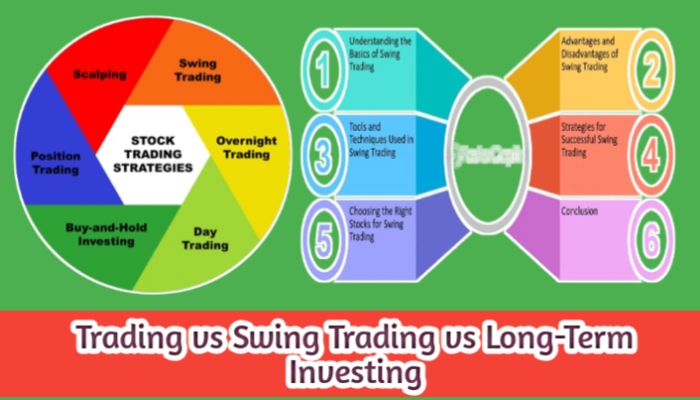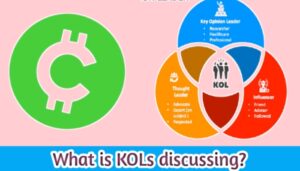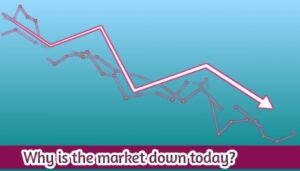Day Trading vs Swing Trading vs Long-Term Investing Day trading, swing trading, and long-term investing are three distinct strategies for participating in the financial markets, each with a different time horizon, risk profile, and required time commitment.
1. Introduction
In the fast-moving world of financial markets, there are multiple ways to grow your money but not all strategies are the same. Some traders open and close positions within a single day, while others hold them for weeks, months, or even years.
2. Understanding the Basics
Before we compare them, let’s understand what these terms actually mean.
Day Trading
Day trading involves buying and selling assets (like stocks or crypto) within the same day — and closing all positions before the market closes.
The goal is to profit from small price fluctuations that occur throughout the day.
Example: A trader buys Bitcoin at $60,000 in the morning and sells it at $60,800 by evening — earning $800 profit.
Swing Trading
Swing trading is a medium-term trading strategy where traders hold assets for a few days to several weeks.
Swing traders try to capture larger price “swings” — or momentum — rather than quick intraday movements.
Example: A swing trader buys Ethereum at $3,000 and sells it at $3,600 after 10 days.
Long-Term Investing
Long-term investing (also called position investing) involves buying and holding assets for months or years to benefit from long-term growth and compounding.
Investors are less concerned about short-term volatility and more focused on fundamental value and future potential.
Example: An investor buys Apple stock or Bitcoin and holds it for 5+ years, ignoring short-term market fluctuations.
3. Time Frame Comparison
| Strategy | Typical Holding Period | Goal | Market Focus |
|---|---|---|---|
| Day Trading | Intraday (minutes to hours) | Profit from small price movements | Technical analysis |
| Swing Trading | Days to weeks | Capture short- to medium-term trends | Technical + fundamental analysis |
| Long-Term Investing | Months to years | Build wealth over time | Fundamental analysis |
4. How Each Strategy Works
a. How Day Trading Works
Day traders depend on real-time data, technical indicators, and chart patterns to identify short-term opportunities.
They aim to make multiple small profits daily that accumulate over time.
Common Assets: Stocks, cryptocurrencies, forex, and futures.
Tools Used:
- Real-time market charts
- Indicators like RSI, MACD, Bollinger Bands
- Level 2 order book
- News-based trading
Example Workflow:
- Identify a volatile asset.
- Analyze price chart and volume.
- Enter a trade based on setup (e.g., breakout).
- Exit quickly once a small profit or stop-loss is hit.
b. How Swing Trading Works
Swing traders analyze both technical and fundamental factors to capture medium-term moves.
They often use daily or 4-hour charts and aim to profit from price momentum rather than daily noise.
Example Workflow:
- Identify a trending stock or coin.
- Wait for pullbacks or breakouts.
- Enter trade and hold for days/weeks.
- Exit when momentum slows or target price is hit.
Tools Used:
- Moving Averages (MA)
- RSI (Relative Strength Index)
- Fibonacci retracements
- Trendlines and chart patterns
c. How Long-Term Investing Works
Long-term investors focus on company fundamentals, project utility, management quality, and long-term growth potential.
They often ignore short-term volatility and prefer to “buy and hold” for years — allowing compounding to grow wealth.
Example Workflow:
- Research strong companies or cryptocurrencies.
- Buy during undervaluation or market dips.
- Hold for 3–10 years.
- Reinvest dividends or compound crypto staking rewards.
Tools Used:
- Financial reports
- On-chain metrics (for crypto)
- Price-to-earnings (P/E) ratio
- Economic trends
5. Risk and Reward Comparison
| Aspect | Day Trading | Swing Trading | Long-Term Investing |
|---|---|---|---|
| Risk Level | Very High | Moderate | Low to Moderate |
| Reward Potential | High (short bursts) | Moderate to High | High (long term) |
| Capital Requirement | High (for margin) | Medium | Any amount |
| Stress Level | Very High | Moderate | Low |
| Time Commitment | Full-time | Part-time | Passive |
| Market Knowledge | Advanced | Intermediate | Basic to Intermediate |
6. Pros and Cons of Each Strategy
Day Trading
✅ Pros:
- Quick profits within a single day
- No overnight risk
- High liquidity opportunities
- Exciting for active traders
❌ Cons:
- Very risky and stressful
- Requires constant monitoring
- High transaction costs
- Difficult for beginners
Swing Trading
✅ Pros:
- Balanced risk and reward
- Can be done part-time
- More time to analyze and plan
- Less stressful than day trading
❌ Cons:
- Exposed to overnight risk
- Requires patience
- Can miss out on sudden market moves
Long-Term Investing
✅ Pros:
- Low stress and time commitment
- Compounding benefits
- Ideal for building long-term wealth
- Lower tax impact (fewer transactions)
❌ Cons:
- Requires patience and emotional control
- Short-term volatility may cause panic
- Market crashes can affect portfolio value temporarily
7. Skills Required for Each Strategy
| Skill | Day Trading | Swing Trading | Long-Term Investing |
|---|---|---|---|
| Technical Analysis | ⭐⭐⭐⭐ | ⭐⭐⭐ | ⭐ |
| Fundamental Analysis | ⭐⭐ | ⭐⭐⭐ | ⭐⭐⭐⭐ |
| Emotional Control | ⭐⭐⭐⭐ | ⭐⭐⭐ | ⭐⭐⭐⭐ |
| Patience | ⭐ | ⭐⭐⭐ | ⭐⭐⭐⭐⭐ |
| Decision Speed | ⭐⭐⭐⭐ | ⭐⭐ | ⭐ |
| Risk Management | ⭐⭐⭐⭐ | ⭐⭐⭐ | ⭐⭐⭐⭐ |
8. Psychology Behind Each Strategy
Trading and investing are not only about numbers they’re about mindset.
Day Traders
Need strong discipline, focus, and emotional control. A single mistake can erase profits.
They must stay calm under pressure and avoid impulsive trades.
Swing Traders
Require balance — being patient for the right setup but decisive when the moment comes.
Long-Term Investors
Need faith in their analysis and the ability to stay invested despite market crashes or news.
They focus on the big picture — not short-term noise.
9. Capital Requirements
Day Trading
- Often requires larger capital to make meaningful profits due to small price moves.
- Many brokers require minimum balances (like $25,000 in the US for pattern day traders).
Swing Trading
- Moderate capital can yield good results.
- Leverage can be used but must be managed carefully.
Long-Term Investing
- Can start with any amount, even small monthly contributions (SIPs, DCA in crypto).
- Best suited for small investors building wealth gradually.
10. Tax Implications
| Aspect | Day Trading | Swing Trading | Long-Term Investing |
|---|---|---|---|
| Frequency | Many transactions | Few per month | Very few |
| Tax Rate (India Example) | Business income (high) | Short-term capital gains (15%) | Long-term capital gains (10%) |
| Record-Keeping | Complex | Moderate | Simple |
Always maintain records and consult a tax professional, especially for crypto or stock profits.
11. Risk Management Techniques
Regardless of your strategy, risk management is key.
Common Tools:
- Stop-Loss Orders: Limit potential losses.
- Take-Profit Targets: Secure gains early.
- Diversification: Spread risk across multiple assets.
- Position Sizing: Invest only a small % of your total capital per trade.
- Avoid Over-Leverage: High leverage increases losses dramatically.
12. How to Choose the Right Strategy
Ask yourself these questions:
- How much time can you give daily?
- If full-time → Day Trading
- If part-time → Swing Trading
- If passive → Long-Term Investing
- How much risk can you handle?
- High-risk takers → Day Trading
- Moderate risk → Swing Trading
- Low risk → Long-Term Investing
- What’s your financial goal?
- Quick profits → Day/Swing
- Wealth accumulation → Long-Term
- Are you emotionally disciplined?
- Day trading requires nerves of steel.
- Long-term investing requires patience and trust.
13. Combining Strategies for Better Results
Many smart investors combine multiple strategies.
Example Plan:
- 70% of portfolio → Long-term investments (Bitcoin, blue-chip stocks).
- 20% → Swing trading for medium-term gains.
- 10% → Day trading for high-risk, high-reward plays.
This diversification allows both steady growth and short-term profit opportunities.
14. Real-Life Example:
Let’s compare three traders investing ₹1,00,000 each:
| Trader Type | Holding Period | Annual Return (%) | Value After 5 Years |
|---|---|---|---|
| Day Trader | Daily trades | 30% (after taxes/costs) | ₹3,71,000 |
| Swing Trader | Weekly/Monthly | 25% | ₹3,05,000 |
| Long-Term Investor | 5+ years | 20% | ₹2,48,000 |
👉 While day trading can yield higher returns, it also carries higher risks and stress.
👉 Long-term investing provides steady growth and compounding without constant attention.
15. Prospects in Crypto and Stock Markets
Both crypto and stock traders use these three approaches, but crypto markets offer 24/7 trading opportunities and more volatility — ideal for day and swing traders.
- Day Trading (Crypto): Ideal for high volatility coins like BTC, ETH, SOL.
- Swing Trading (Crypto): Great for altcoin trends.
- Long-Term (Crypto): Perfect for Bitcoin and Ethereum believers.
16. Tools and Platforms
Day Trading Tools
- TradingView
- Binance, Bybit, KuCoin
- Real-time alerts (Coinigy, DexTools)
Swing Trading Tools
- Moving average strategies
- Fibonacci & RSI analysis
- CoinMarketCap trends
Long-Term Investing Tools
- Fundamental analysis websites (Yahoo Finance, CoinGecko)
- Portfolio trackers (Delta, CoinStats)
17. Common Mistakes to Avoid
- Overtrading or revenge trading
- Ignoring stop-loss
- Following hype or social media tips blindly
- Lack of strategy or emotional control
- No diversification
18. Conclusion
All three methods Day Trading, Swing Trading, and Long-Term Investing can be profitable, but success depends on your personality, time, and goals. Day Trading is for aggressive, full-time traders who thrive on adrenaline and quick decisions. Swing Trading suits those who want balance — active trading without daily stress. Long-Term Investing is ideal for patient investors aiming to build wealth gradually and securely.

















